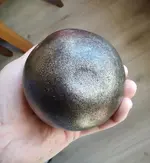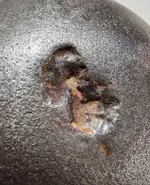For sure not a meteorite.
A sphere with a diameter of 9.5cm would have a volume of 448.9 cubic centimetres and, if it weigh 3,670g, then it’s specific gravity would be 8.18.
Allowing for minor deviations, that’s not a million miles from the specific gravity of iron/steel at around 7.9
If you have a cannonball of the similar size which weighs only half as much, then that would have to be hollow.
the other cannonball is also solid, here is a wrightup of annual meteoritical society meeting:
Density: Early density work [3] looked at slices thinner than
5 mm selected to avoid inclusions; their typical densities ranged
between 7.85 and 7.9 g/cm3, with low nickel (<6%) irons as low
as 7.6 g/cm3 and high nickel (>18%) irons at 8.05 g/cm3. As
expected, our much larger samples containing inclusions have
densities at or lower than these values, ranging from 7.47 to 7.96
g/cm3. There is no correlation with literature Ni values, indicating
that this variation is due to the presence of inclusions. Assuming
an iron density of 7.9 g/cm3 and an inclusion density of 5.0 g/cm3
the proportion of inclusions ranges from 0 to 15% by volume, or
0% to 10% by mass. Both sulfides and oxides of iron can have
similar densities (4.9 g/cm3 and up to 5.2 g/cm3 respectively) so
differentiating between the two via density alone is not feasible.








